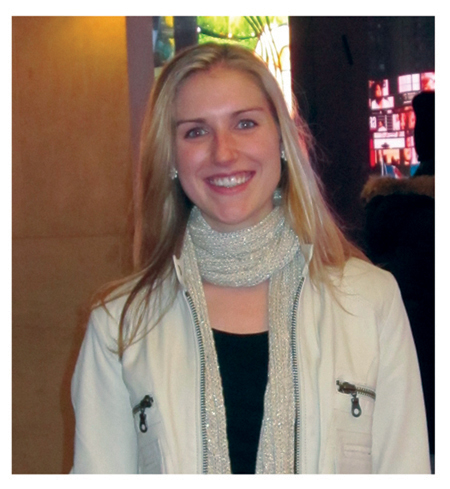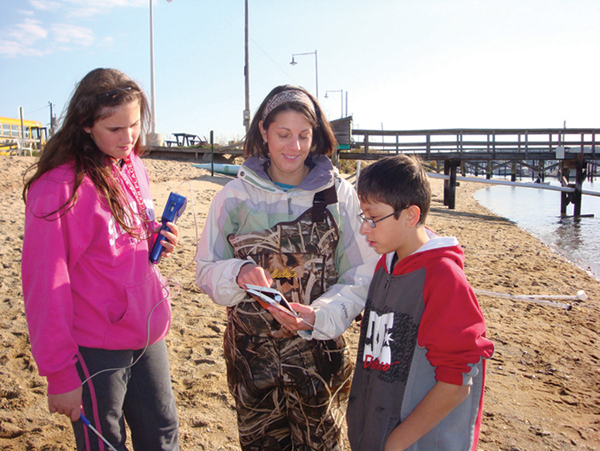Since the 1970s, New York Sea Grant has funded more than 600 research projects, and more than 600 graduate students, many of whom are in a position of influence relative to the marine and Great Lakes districts, whether in government, academia or industry. Many of our faculty researchers are aided by capable graduate students who are fully involved as investigators and funded as Sea Grant Scholars. Several issues of NY Coastlines have featured our former Scholars such as Dr. Christopher Gobler, Karen Chytalo and Doran Mason (see "Related Links" at sidebar). They are often the in-the-field and in-the-lab eyes, ears, and hands of NYSG’s excellent research program.
Recent Sea Grant Scholar Sean Bratton, who won additional funds through a thesis completion award in Fall 2011, had an opportunity to discuss his research on the interaction of the atmosphere and the waters of Long Island Sound with Dr. Jane Lubchenco, administrator of NOAA, during her May 2011 visit to Stony Brook University (SBU). Says Sean, “I appreciate the opportunity to grow as a scientist while working with well-known researchers in the field who are fulfilling Sea Grant’s mission of finding scientific solutions to the socioeconomic issues of our coastlines.”
Over the years, NYSG has also supported 33 Knauss Fellows, a NOAA-funded program that places highly-qualified graduate students from the nation’s 32 Sea Grant programs in federal government host sites, developing and implementing national policies related to marine, coastal and Great Lakes resources. The program is named for one of Sea Grant’s founders, former NOAA Administrator John A. Knauss. In 2007, SBU’s Lynn Abramson was selected. Says Lynn, “The Knauss Fellowship was an unparalleled opportunity to work on environmental policy and learn more about the decision-making process. Now, as a Senior Legislative Assistant in the Office of Senator Barbara Boxer, I still consistently draw upon the skills and knowledge I developed as a Fellow.”
After receiving a Masters of Public Administration in Environmental Science and Policy from Columbia University, Jeb Berman was NYSG’s 2009 Knauss Fellow who was assigned to Congressman Mike Thompson of California. Now Director of Government Relations at the National Marine Sanctuary Foundation, Jeb says, “As a Fellow, I had a front-row seat to observe how Congress actually works. It was exciting to be at the intersection of local and national ocean policy issues, giving me amazing opportunities to connect with diverse government, industry, academic, and nonprofit institutions on a variety of ocean issues.”
 Jillian Cohen
Jillian Cohen (pictured at right) is the 2012 Knauss Fellow. Jillian, who received her Masters of Science from Cornell in 2009 and is currently a PhD candidate, joins the staff on the US House Committee on Natural Resources where she’ll work closely with the Subcommittee on Fisheries, Wildlife, Oceans, and Insular Affairs which has jurisdiction over fisheries management, wildlife conservation, estuarine protection, and Sea Grant programs. “Given the broad purview of the Committee and Subcommittee,” says Jillian, “I look forward to interacting with a variety of policy makers, environmental managers, and researchers on a range of topics. The experience will give me a chance to connect with scientists and decision makers at NOAA and the Fish and Wildlife Service.”
The National Marine Fisheries Service (NMFS) is another avenue of fellowship for qualified graduate students. NYSG’s current NMFS Fellow, Skyler Sagarese says, “Professionally, my NMFS-Sea Grant fellowship has taken me behind the scenes, from collecting and processing catches aboard the R/V Henry B. Bigelow to illuminating discussions of modeling techniques with cutting-edge NMFS scientists. Personally, I’ve been challenged and stretched, and my passion for a career in fisheries science further ignited.” Her fellowship has borne fruit with the authorship of an article in a recent issue of Northeastern Naturalist (Sagarese, S.R., R.M. Cerrato and M.G. Frisk. 2011. Diet composition and feeding habits of common fishes in Long Island Bays, New York. Northeastern Naturalist 18(3): 291-314).
Over the years, NYSG has also worked with undergraduate students through the Research Experience for Undergraduates at Stony Brook University as well as Stewards working in the dunes region of eastern Lake Ontario and along the Salmon River. High school students participating statewide in the annual Bay Scallop Bowl or in the biennial Great Lakes Student Summit, have also gained insights from NYSG’s coastal educators.
In 2008, New York Sea Grant started a Sound Stewards program in conjunction with Brookhaven National Laboratory’s Open Space Stewardship Program to increase stewardship throughout Long Island Sound (LIS). Working with such partners as NYS Department of Environmental Conservation and NYS Office of Parks, Recreation and Historic Preservation, the Sound Stewards program involves younger students in research projects that teach them about problems facing LIS, while collecting data that could be used by partner agencies. To date, 1,700 students have participated in this program.
— Barbara A. Branca

With help from NYSG’s Larissa Graham (c), North Country Middle School students from Miller Place have collected water quality and other data in Mt. Sinai Harbor since 2008. The Harbor has experienced dredging and wetland loss over the years. The students compare their Mt. Sinai data with data that their teachers collect at a healthy wetland as well as do their own research projects. Partners on this project are the NYSDEC and the Town of Brookhaven. Photo courtesy of North Country Middle School